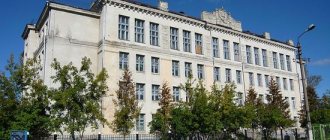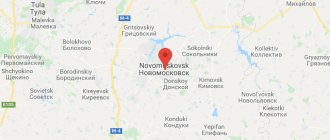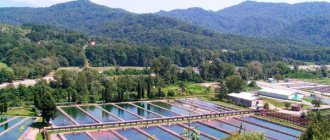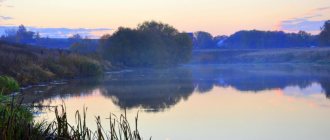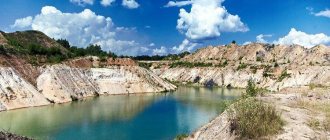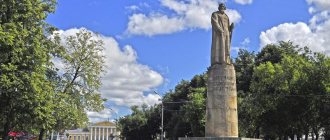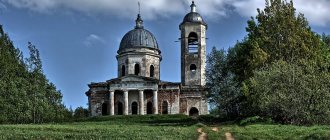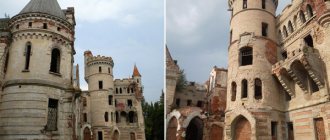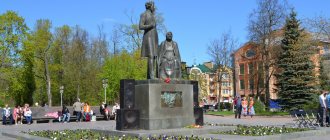Aleksin is a historical pearl of the Tula region, a city with centuries-old history and culture. It was located on the banks of the full-flowing Oka River, starting from the 13th century, it was founded by the Prince of Moscow, Daniil Alexandrovich, and was a trade and defensive point during the years of the Golden Horde dominance. The old part of Aleksin - a distinctive historical center - is very different from the modern buildings on the left bank of the river. The two parts of the town are connected by road bridges. It is one of the historical sites of federal significance, and some of Aleksin’s sights are protected by the state. Let's look at the most interesting places in the city; photos and descriptions of them will also be here, as well as addresses with names.
Interesting natural places
The city of Aleksin is famous for its unique natural sites, which are valued not only among residents of the area, but are also often visited by tourists.
Aleksin Bor
- Coordinates – 54.533500, 37.082687.
This forest is a protected area on the right bank of the Oka. A majestic pine forest spreads over an area of 400 hectares. In a virgin corner of nature, which is under state supervision, there are health boarding houses, tourist recreation centers and a children's camp.
The healing properties of the air, the purity of water sources and the beauty of the area, combined with well-established infrastructure, attract more and more tourists and travelers every year. Mostly, the natural monument is visited for family time, often with even small children.
Holy natural springs
In the city and in nearby settlements, there are three known springs that have healing properties.
- Coordinates – 54.644503, 37.203794.
Not far from the Bobrishchev-Pushkin estate, which is located in the village of Egnyshevka, there is a holy place - the source of the healer Panteleimon. According to legend, several centuries ago a lonely old man settled near a natural miracle. Every day the monk prayed for the believers who came for healing. It was rumored that St. Panteleimon was secretly visited by the imperial family of Nicholas II. After the revolution, the source was destroyed and the hermit was sentenced to execution. A few years later, the spring began to flow with renewed vigor - and to this day its waters heal many diseases.
- Coordinates: 54.541264, 37.090449.
The Zharensky holy spring is a popular place among pilgrims. At the end of the 19th century. was consecrated with the icon of the Smolensk Mother of God. The spring comes out of a rocky cliff and has a unique mineral composition.
- Coordinates – 54.483986, 37.077834.
The source of the healer Euphrosyne, according to legend, was dug by the saint herself. Its healing properties have long been valued by parishioners of the Holy Kazan Church. The area around the spring has been landscaped - a chapel and two baths have been created here.
Bald Mountain
- Coordinates – 54.555939, 37.231158.
An amazing place, beloved by tourists, located on the coast of Vashana, a tributary of the Oka. The hill got its name because of the sparse vegetation and open area, blown from all sides.
Bald Mountain is also famous for its archaeological finds. Local historians discovered caves that date back to the Paleolithic era.
At the top of the natural site, festivals are held and tourist meetings are organized. There is an opinion among regulars that the hill has magic, and scientists have proven more than once that Bald Mountain is a geopathogenic zone.
Petrovsky Park
- Coordinates – 54.481595, 36.989975.
This square is located near the Palace of Culture named after. A.P. Chekhov. On its territory there is an Obelisk for returning fellow countrymen. Guests of Petrovsky Park note that it is very quiet and peaceful, you can easily walk with a stroller and older children. There are also swings, although most of them are rusty. And many people recommend walking here before dusk, since in the evening you can hardly see anything - the lighting is very poor.
Aleksin is in 6th place in terms of population in the Tula region
Tulastat yesterday posted data on the population of the Tula region as of January 1, 2021. The total figure is 1,499,486 people. That is, we were only 515 residents short of remaining on the list of a region with a population of one and a half million people?
If so, that's sad. Although the hope of not losing the status of “one and a half million people” still remains. For the above data, as specifically noted in the summary, is a “preliminary assessment.” The fact is that there is still no accurate information on the balance of external migration to the region. So far, there is data for 11 months, according to which the preponderance of those arriving for permanent residence (permanent residence) in the Tula region over the departing residents is about five thousand. If December turns out to be equally positive, then it is possible that the benefit of compensation for the “missing” half a thousand people will be “clarified”.
However, even if this happens, the information will still be sad. Because in any real “demographic and migration” scenario, by the summer of 2021 the Tula region is almost guaranteed to lose its recent status. And its population will become less than one and a half million people. With the prospect of subsequent reduction and further. This process - under the best circumstances - should end in 2020-2021. Due to positive migration – if it continues – we should formally reach “zero”. But the excess of birth rates over deaths will apparently have to wait until 2025 or even 2028.
By the number of residents of cities, districts, municipalities. Lira, of course, “Big Tula” - 552,071 people. The regional center is so far the only “subject” of the province where the number of residents has grown slightly – by two to three hundred people. Naturally, at the expense of visiting people. The mortality rate in the hero city is also higher than the birth rate, as elsewhere in our country. For information: of this number, approximately 64 thousand people are residents of the Leninsky district. That is, the population directly in the city of Tula is about 488 thousand people. And in reality, the status of “half a million” here was also lost several years ago. In this regard, there is a bad, but, alas, slightly real joke: when the potential of the Leninsky district ends, Tula, in order to maintain the status of a city of “half a million,” will have to annex the Shchekinsky district. Then it will be enough for a long time, and in terms of territory we will become the largest city in Russia after Moscow.
In second place is Novomoskovsk, 137,684 people. Further, in descending order: Shchekinsky (106,102), Uzlovsky (81,725) and Kireyevsky (73,067) districts, the cities of Aleksin (67,770) , Donskoy (63,822) and Efremov (56,931), as well as Bogoroditsky (51,202) and Suvorovsky (34,882 people) districts. The minimum population by district is Kamensky (8,836), Arsenyevsky (9,676), Kurkinsky (9,676), Teplo-Ogarevsky (12,143) and Odoevsky (12,777 people). And the list is completed by two mysterious “micro-municipalities” in their socio-economic essence - the villages of Novogurovsky (3,431) and Slavny (1,887 people).
Well, let’s not forget to mention the smallest city in the country, which is also located in the Tula region. This is the city of Chekalin in the Suvorovsky district, where today less than 1,700 people live. Although, according to Russian laws, city status is assigned to settlements with a population of more than 10 thousand people. But this is an exception. And, by the way, it’s not the only one with us. There is also the city of Sovetsk in the Shchekinsky district, less than 9 thousand people live there, and this number is constantly decreasing...
Aleksin and its museums, cultural centers
Aleksinsky Museum of Art and Local Lore
- Address: Sovetskaya, 38.
The museum is located in the city center, in the former house of merchant A.M. Maslov, built in the 18th century. The first exhibitions opened to visitors in 1980 and were replenished with hundreds of exhibits every year.
The Aleksinsky Museum has a wealth of materials on the history, art, geology and ethnography of the city, which are housed in 13 main and several interchangeable exhibition halls. The topics of the exhibitions are varied.
In the nature department of the Aleksinsky region you can learn about the flora and fauna of the local lands. The historical part of the attraction will tell about the life of the Vyatichi tribe who inhabited the lands on the Oka coast, about the merchant way of life through interior exhibitions. The postal history section is one for the entire museum system of the Tula region, where a large collection of postal supplies is collected, something like this cannot be found even in Tula .
The museum constantly opens art exhibitions and organizes literary and theatrical evenings.
House of Culture named after Chekhov
- Address – Metallistov, 4.
Museum exhibitions are often held at the Anton Pavlovich Chekhov House of Culture in the Petrovsky microdistrict. Here, theatrical performances are organized for guests, various children's clubs operate, and discos are organized for young people.
The building of the cultural center is very beautiful - it stands out against the backdrop of urban development. The color of the facade is light green. It itself is decorated with four whitewashed columns and a balcony. It’s also cozy inside, the chairs are comfortable, and the stage is clearly visible from any row.
On topic - TOP attractions of the Tula region
General information about the city
Aleksin is located in the Tula region on the banks of the Oka River. The settlement was founded in the 13th century. Prince Daniil Alexandrovich as a trading settlement and at the same time a defensive fortress to protect the borders from the troops of the Golden Horde.
The territory of Aleksin is divided into 2 parts by a river, across which several bridges were built. In the Old Town (Zarechye) there are mainly ancient buildings, including:
- restored churches;
- former merchant houses;
- dilapidated and preserved estates.
On the other bank there are areas built up during the USSR, as well as modern buildings.
Temples and churches of Aleksin
Aleksin's temple architecture combined the features of ancient Russian temple architecture and modern church buildings. The abundance of holy places has made the city a real pilgrimage center.
New and Old Dormition churches
- Address - pl. Sobornaya, 1.
On the hill of the Cathedral Hill there are ancient examples of Aleksin's church architecture - the old and new Cathedral Churches of the Dormition of the Mother of God.
The construction of the old cathedral was erected at the end of the 17th century at the expense of local boyars and became the first stone building in Aleksin. At the beginning of the 19th century, Aleksin merchant I.A. Maslov provided financial assistance during the construction of the new temple. Both parishes embodied the restrained harmony of the proportions of church architecture.
It is noteworthy that after the opening of the new Assumption Church, the future Russian autocrat Alexander II visited it. That is why, before the revolutionary years, imperial crowns adorned the crosses of cathedrals.
In 1917, the churches were first closed, and then began to be used for economic needs. The buildings fell into disrepair and were on the verge of disappearing. In 2005, the old cathedral was included in the federal program for the restoration of architectural monuments. The restorers carefully tried to replicate the old masonry to ensure the integrity of the image. In 2013, the church building was re-illuminated.
In the new Assumption Church, restoration work began in 2015. At the moment, the 3-tier bell tower, built in 1829 not far from the Orthodox shrine, is being restored.
Holy Kazan Convent
- Address: Kolyupanovo village.
In the village of Kolyupanovo, Aleksinsky district in the 1990s. By the most holy decree of the Patriarch of Moscow, a monastic monastery was erected. The site of the founding of the convent is the land where the temple of the icon of the Mother of God previously existed, dating back to the 17th century. Particularly revered by local nuns is St. Efrosinia Kolyupanovskaya.
According to historical sources, the girl was one of Catherine II's ladies-in-waiting. She renounced the pomp of social life and secretly fled, wanting to hide from the world. Mother spent her entire life traveling, healing people. Having settled in the village. Klyupanovo dug a well with her own hands, the waters of which are still considered miraculous. In memory of the blessed old woman, a marble slab was installed on the territory of the monastery.
Today, next to the Holy Kazan temple complex, the Church of the Holy Trinity was built along with two indoor baths. Every year crowds of believers come to Aleksin to venerate the tomb of St. Euphrosyne and to feel the wonderful properties of the holy spring.
Tsarevich-Alexievsky Church
- Coordinates – 54.526094, 37.070883.
Among the pines of the Aleksinsky Forest, you can barely notice a small church building, which was erected by parishioners in 2006. There was once a Soviet children's camp here, but since the 2000s. These lands were transferred to the possession of the Tula diocese. The temple is dedicated to the great martyrs of the royal family and is an example of Russian wooden architecture.
St. Nicholas Cathedral
- Address: Sovetskaya, 43.
At the end of the 18th century, this beautiful cathedral was erected with donations from the Savostin brothers, Aleksin merchants. The architectural monument was founded in honor of St. Nicholas the Wonderworker, whose image occupies a special place on the carved iconostasis.
The combination of baroque and classicism features gave the building majestic elegance. The appearance is striking: a snow-white facade, a magnificent row of columns, and the undoubted difference between this parish and others in Aleksin is the sonorous 2-tier bell tower.
During the Great Patriotic War, a bomb fell on the church building and almost destroyed the architectural masterpiece. Since the late 1990s. restoration work is underway here. A parish school is open for the youngest parishioners.
Top 10 attractions of Aleksin
It is difficult to see all the sights in Aleksin in 1 day. Therefore, for future tourists, I have compiled a list of the most interesting places that I definitely recommend visiting.
Church of the Transfiguration of the Lord
The village of Spas-Konino is located 15 kilometers from the city of Aleksin.
Erected in 1860 in the village of Spaso-Konino with donations from parishioners and funds allocated by the landowner Frolov.
The Church of the Transfiguration of the Lord is located on a hill surrounded by trees. The snow-white facades of the church go well with the domes and blue roofing. The bell tower is decorated in the same style. At the main entrance, the porch is paved with multi-colored tiles.
Previously, at this place at different times there were 3 wooden temples, 2 of which burned down, and 1 was destroyed.
Lenin monument
The monument to V.I. Lenin is located in the center of the city market square.
The monument to the leader of the revolution was erected in 1969; Egorov is considered the sculptor. The monument is included in the historical and cultural list of objects of regional significance.
On a high green pedestal, Lenin stands at full height, with his hand raised high and in a cloak. Surrounded by fir trees and other trees, the leader seems to be addressing the people. Next to the monument there are flower beds; the monument itself is located in a green meadow.
Church of the Resurrection
The village of Bogucharovo is located 10 kilometers from the city of Aleksin.
Erected in 1803 with funds donated by the landowner I. Polibin. The temple is located at the highest point of the village of Bogucharovo, from here there are beautiful views of the surrounding area, forests and mountains are clearly visible. Previously, there was a wooden chapel on the site of the church.
You will also like: Virtual tour of the Kremlin for children: interesting places
Now the temple is in a dilapidated state, immediately behind it there is an abandoned ancient cemetery.
However, you can see the remains of the building and walk around inside the church. In some places, artistic paintings can be seen on the walls of the temple, and there are tiles on the floor. Windows and doors are missing or in dilapidated condition.
Aleksin-bor
Aleksin-bor is located on the banks of the Oka River; on the territory you can find a beautiful lake and spring.
The protected area is located on the right bank of the Oka River and covers an area of 400 hectares. Pines grow here predominantly, although other trees are also found.
Thanks to the fresh air, crystal clear water from forest springs and the absence of pollution, boarding houses, tourist complexes and a camp for children have been built in the forest. Not only school students, but also adults, both locals and tourists, regularly come here to improve their health.
Museum of Art and Local Lore
The Art and Local History Museum is located in the historical part of the city.
The exhibition is located in the very center of Aleksin in a house that formerly belonged to the merchant A.M. Maslov. For the first time, visitors were able to see the museum’s collections in 1980. Among the exhibits are works of art, historical documents, and geological finds. In total, the museum has 13 main and several additional rooms intended for holding art exhibitions, literary and theatrical evenings.
In the Nature Hall you can get acquainted with the peculiarities of the local flora and fauna. In the historical room, visitors will learn about the life of the Vyatichi people and merchant life. Also, the Aleksinsky Museum houses one of the largest collections of postal supplies.
Giant chair
A huge chair acts as a canopy in front of the entrance.
In Aleksin there is a small furniture store located in a 2-story building. The facades of the building have not been renovated for a long time, but the canopy over the main entrance is considered a local landmark. It is made in the form of a large chair, the wooden parts of which are painted brown. This is one of the favorite places where visitors like to take pictures.
House of Maslovs
The mansion is a significant monument of urban architecture of the 18th century.
The mansion was built in the 18th century. and is considered one of the largest buildings in the Tula region. The facades of the house are painted in white and yellow shades, the roof is made of metal. The main part of the mansion, consisting of 3 floors, has massive columns. Many of the house's windows are decorated with arched stucco.
The architectural ensemble of the estate consists of the main estate and outbuildings attached to it. Now the building houses a local history museum and a regional house of culture. The mansion is included in the list of objects protected by the state.
You will also like: Nebug attractions: what to see in the area, on your own
Bald Mountain
Some people who have visited the bald mountain near Aleksin talk about strange flying objects in the area.
It is located next to a tributary of the Oka - the Vashana River. The place was called “Bald Mountain” not because of the presence of witches, but because of its location in an open area, blown from all sides by winds. In addition, there is little vegetation here.
Bald Mountain is also famous for its archaeological finds. During excavations, scientists discovered caves dating back to the Paleolithic era. Festivals are often organized at the summit. Local residents believe that the mountain is magical, and scientists have proven that the hill is a geopathogenic zone.
Holy Kazan Convent
The monastery was founded in 1995 by decree of Patriarch of Moscow and All Rus' Alexy II.
Located in the village of Kolyupanovo. According to legend, Catherine II's maid of honor, Euphrosyne, escaped from the palace and took refuge in this area. The girl was famous for her gift of healing people, and subsequently dug a well with her own hands, the water from which is considered healing even now. In memory of Saint Euphrosyne, a monastery was built and a marble slab was installed.
Manor's house
The Manor House in Aleksin is included in the list of attractions of the Central region of Russia.
Erected in 1773 in the classicism style. It was a 2-story brick house, to which utility rooms were attached.
Now the mansion is in a ruined state, you can only examine the ruins. There is a park next to the house.
Architectural landmarks
The city of Aleksin boasts interesting architectural sites. The remains of manorial estates of the 18th-19th centuries located along the banks of the Oka River are still breathtaking.
House of Berov
- Address: Petrovsky microdistrict.
An interesting place in Aleksin is a dilapidated 2-story building of the 18th century, which received the popular name “manor’s house”. The ancient estate is located on the high coast of the Oka River and was once the center of social life in the city.
The history of the architectural complex begins in the late 1770s, when these lands were inherited by a noble nobleman and close associate of Catherine’s court, Ivan Petrovich Tyufyakin. The picturesque landscapes and amazing views of the river did not go unnoticed by the nobles.
In 1773, construction began on a majestic manor complex in the classicist style. The central façade of the manor house had a semicircular projection with a spectacular Doric colonnade. Above it was a terrace with an excellent view of the surrounding area. Inside there were state rooms and halls with stucco moldings and tiled tiles. The house was surrounded by a garden and park area.
The last owners of this architectural landmark of Aleksin were the family of the famous official V.V. Bera. The new owner's hobbies were art and literature. The guests of the estate were Chekhov, Scriabin, Pasternak, who stayed in the attached outbuildings.
Despite the fact that the architectural creation is dilapidated these days, there are no fewer people wanting to admire the noble residence.
Kolosovsky Castle
- Address – village. Kolosovo.
On the outskirts of Aleksin there is a “Gothic miracle” - an architectural structure of the 19th century. The estate was founded by the nobleman Dmitry Aleksandrovich Chertkov on the banks of the Oka.
From the main road, guests turned into a linden alley that led to a large carved gate. The snow-white main house, decorated with columns and massive windows, was located in the center of the ceremonial avenue-park.
The appearance of the building and the entire estate was decorated in a “foreign” manner. Initially, the architectural structure was built in the Empire style, but at the end of the century, the new owner, K.N. Paskhalov, transforms the Chertkovsky house into a Gothic castle.
Vaulted arches and the main tower with an open area added mystery to the estate. A marble staircase with a fountain complex was erected on the adjacent territory. There is a huge winter garden inside - a special pride of the owners.
On the estate, on one of the outbuildings, a wooden clock tower was built. The chapel was clearly visible from the windows of the Kolosovsky Castle. The building with the dial remains today. The estate in Kolosovo attracts tourists with its legend about the underground passage. Going down to the Oka River along a dilapidated staircase, you can find the arched vault of the exit from the underground tunnel.
Now the architectural complex is in disrepair. The interior was destroyed by fires, and the exterior conveys only part of the former beauty of the Gothic castle.
Ryurikovo station
- Address: Ryurikovo village.
At the end of the 19th century. in the village of Pershino there was an estate owned by the uncle of Emperor Nicholas II - Grand Duke Nikolai Nikolaevich. Thanks to his diligence, the village thundered not only throughout Russia. Even in European secular circles there was talk about the prince’s exemplary dog hunts.
Not far from the estate, on the orders of a member of the royal family, Moscow architects worked on the construction of a railway station. The spectacular structure amazed the eminent guests, who were then impressed and did not notice the shortcomings of the tedious path to Pershino. The Ryurikovo station was built in pseudo-Russian style. The building resembled a tower with a main entrance and a patterned facade. According to historical sources, there was once even a station church here.
This architectural masterpiece is deteriorating and collapsing these days. The station building is not in use today.
City `s history
It was founded in 1236 as a wooden fortress, apparently by immigrants from the settlements of the Chernigov principality destroyed by the Tatar-Mongols.
According to legend, the name Aleksin was given in 1298 by Moscow Prince Daniil Alexandrovich after his son Alexander (from the derivative form Alex, Alex). Sometimes the name is associated with the name of Metropolitan Alexei, to whom the city was given for feeding in 1354. In the 14th century Aleksin was at one time the center of an appanage principality, then it ended up in the possession of Metropolitan Peter.
In 1348, the Tatars, led by Murza Temir, burned the city and returned to the Horde with great booty. Soon after this raid, the city was rebuilt again, but on the right bank of the Oka, on the site of an ancient settlement.
In 1392, the Grand Duke of Moscow Vasily I received Aleksin from Metropolitan Cyprian in exchange for a parish in the Rostov land.
In 1396, Aleksin became a city bordering the Grand Duchy of Lithuania.
In 1401 he was granted appanage to the Serpukhov prince Vladimir the Brave. After his death in 1426-27. from the pestilence of most of the Serpukhov princes, the city again found itself part of the Grand Duchy of Moscow.
In 1472, the defenders of Aleksin played an important role in repelling the great campaign against Rus' by Khan Akhmat. The city was besieged, but the time spent capturing Aleksin was used by the Russians to gather forces to the battle site. The Oka line turned out to be firmly occupied by Russian regiments and the khan did not risk a decisive battle. For the first time in the history of the Tatar-Mongol yoke, the khan returned to the Horde without daring to fight the Russian army.
After the fire of 1472, the city was moved to a cape located 2 kilometers downstream, bounded by the steep banks of the Oka and its tributary Mordovka.
After a big fire it was rebuilt in 1656-1658.
At the beginning of the 17th century. during the uprising of I.I. Bolotnikov, the residents of Aleksin fought in the ranks of the peasant army and defended the city from the troops of Vasily Shuisky.
In the 15-16th centuries. an important military fortress, by the beginning of the 18th century. has lost its meaning.
In 1729 near the mouth of the river. An ironworks was built in Myshega, known in the first half of the 19th century. as a figure casting plant (the fence and gates of the Alexander Garden of the Moscow Kremlin, decorative decorations of the Triumphal Arch in Moscow, etc.) were made here.
In 1768, almost all of Aleksin was destroyed by fire.
Since 1777 it has been a district town of the Tula governorship.
In 1958, Aleksin included the working villages of Myshega (2.6 thousand inhabitants, 1939), Petrovskoye (3.1 thousand inhabitants, 1939), Vysokoye (9.5 thousand inhabitants, 1939).
Historical monuments and memorials
Residents of Aleksin honor the memory of heroes and figures who glorified their native land, because the exploits of their ancestors are immortal, and their names are immortalized for the future descendants of the city.
Memorial Mound of Glory
- Coordinates – 54.519942, 37.232805.
During the Great Patriotic War, the front line was located on the territory of Aleksin, which was heroically defended by the 238th Infantry Division G.P. Korotkova. In the middle of the 20th century. On the site of the heroic confrontation, a memorial complex was erected - the Mound of Glory.
In the center there are stand plates with the names of the defenders and the Eternal Flame is constantly burning. Nearby there is a monument to the Unknown Soldier and a small area where an artillery gun flaunts on a pedestal. The pine plantations around the memorial give the place an atmosphere of eternal tranquility.
Memorial complex in memory of the events of 1472
- Address: Ratnaya Glory Square.
1472 became a turning point in the history of not only the Aleksin fortress, but also all of Moscow Rus' as a whole. The Khanate of the Golden Horde did not stop trying to subjugate the Russian lands.
The military garrison of the Alexin Fortress, at the cost of its existence, blocked the possible advance of the Golden Horde army deep into Rus'. Khan Akhmat did not expect to receive resistance from a small defensive point and turned his hordes back. Scientists believe that this event could have become the breaking point of liberation from the rule of the Horde.
In memory of the heroism of ancient Russian warriors, a historical memorial was opened in 2001 on the central street of the city. The central place is occupied by a stele, surrounded by massive slabs with images of military operations.
Story
According to legend, Aleksin was founded at the end of the 13th century by the first Moscow prince Daniil Alexandrovich, the youngest son of Alexander Nevsky, but the official date of birth of Aleksin is considered to be 1348, under which it was first mentioned in the Nikon Chronicle:
“...Prince Temir of Orda, come with your army to the city of Oleksin of the Holy Wonderworker Peter, Metropolitan of Kyiv and All Rus', and make the settlement easier...”
According to other sources, the foundation of Aleksin dates back to 1236.
In 1472, Khan of the Great Horde Akhmat entered Russian soil with significant forces. Moscow did not know exactly where Akhmat was heading and therefore took the usual precautions. Therefore, on July 29, 1472, the enemy was able to almost unhindered approach the wooden fortress - the city of Aleksin. The Alexinians selflessly began to fight the enemy. Chroniclers who described the battle for Aleksin noted the heroism and courage of the townspeople:
“...the citizens defended themselves bravely and many Tatars died. Soon, however, there was nothing left to defend with; there was neither an arrow nor a spear left,” writes historian S. M. Solovyov.
On July 30, the Tatars set fire to the fortress, but the townspeople bravely defended themselves; The merit of the Aleksinites is that it was they who held back the superior enemy forces for two days. During the time that the battle of Aleksin was going on, Ivan III managed to send troops to defend Moscow.
The historical novel “The Forerunner” (1987) by the St. Petersburg writer and military historian I. N. Loschilov is dedicated to the heroic defense of Aleksin from the army of the Golden Horde Khan Akhmat in 1472.
After the events of 1472, Aleksin throughout the 15th-16th centuries remained an important outpost of the “Berega” - a defensive system created along the Oka from Kolomna to Kaluga to repel Tatar raids. During the period of formation and strengthening of a single centralized Russian state, Aleksin was the location of the grand ducal “regiment of the right hand.” In 1566, it was assigned to the personal possessions of Ivan IV the Terrible, as a result of which it became the only city on the right bank of the Oka that was included in the oprichnina.
During the Time of Troubles at the beginning of the 17th century, Aleksin took part in the events associated with the uprising of I. I. Bolotnikov in 1605-1606, and then suffered new devastation from the Polish-Lithuanian interventionists.
By the beginning of the 50s of the 17th century, only about 450 people lived in Aleksin. In 1728, near Aleksin on the Myshega River, the Mosolov brothers built the first ironworks, which is now called Tyazhpromarmatura.
In 1777, Aleksin received the official status of a district town of the Aleksinsky district of the Tula governorate (since 1796 - the Tula province).
The city began to actively develop in the 19th-20th centuries, when it became the center of the sawmill and metallurgical industry, and also after the construction of the Kaluga-Tula railway in the mid-19th century.
On January 18 (31), 1918, Soviet power was established in Aleksin and Aleksinsky district.
In the early 1920s, the first dachas appeared in Aleksin, near a centuries-old pine forest. The great Russian writer Anton Pavlovich Chekhov also loved to relax in Aleksin.
In 1924, during the zoning of the Tula province, 4 districts (enlarged volosts) were formed in the Aleksinsky district: Aleksinsky, Nenashevsky, Popovsky and Serpukhovsky; at the same time, Aleksin became the center of the Aleksinsky district (later the districts were consolidated). On December 1, 1924, the Aleksinsky district was abolished, and the Aleksinsky district came under provincial subordination. In 1929, the Tula province was transformed into the Tula district of the newly formed Central Industrial (from June 3 - Moscow) region; however, on August 21, 1930, the Tula District was liquidated, and the Aleksinsky District became directly subordinate to the Moscow Region. Finally, on September 26, 1937, by a resolution of the Central Executive Committee of the USSR, the Tula Region was separated from the Moscow Region, into which Aleksin and the Aleksinsky District were transferred.
In 1933, the government decided to build a chemical plant (plant 100) in the Moscow region, which included Aleksin. On March 27, 1941, the first thermal power plant was put into operation, and at the end of May, workshop No. 3 of plant 100 was put into operation.
During the Great Patriotic War, Aleksin played an important strategic role. On October 14, 1941, after the German troops occupied Kaluga, the 238th Infantry Division was transferred to the area of the city of Aleksin to defend it and prevent a breakthrough on the Moscow-Tula road. German troops managed to occupy the city for a while, but it was liberated on December 17, 1941.
During the war, 7,662 Aleksin residents died a heroic death. Ten people were awarded the title of Hero of the Soviet Union (I. A. Ageev, N. V. Bychkov, V. R. Voronkov, I. N. Makarov, G. G. Nikolaev, M. S. Polivanova, P. Ya. Polyakov , P. I. Romanov, I. I. Savoshchev, I. A. Filatov. Among the awarded Aleksinites are two full holders of the Order of Glory: I. K. Lepikhov and S. D. Petrov).
On July 12, 1958, by decree of the Presidium of the Supreme Soviet of the RSFSR, the city of Aleksin was classified as a city of regional subordination; At the same time, the working villages of Vysokoye, Myshega and Petrovsky were included in the city limits.
The peak of the city's prosperity occurred in the 1970s, when the Chemical Plant reached its greatest prosperity, being the largest producer of gunpowder. It was then that the Bor microdistrict was built up and the Zhalka park opened in the Gorushka microdistrict, which was rightfully considered the most beautiful park in the city, combining slender pine trees and wonderful artistic design. At the same time, the Myshega plant is reoriented to the production of shut-off valves for the oil and gas industry.
On January 11, 2011, the old bridge over the Oka River was opened after reconstruction. In Aleksin there are now two bridge spans along which vehicular traffic occurs.
At the new stage of development of the city and region, two new ones and TulaCement have now been built. In 2012, the defense enterprise Aleksinsky Chemical Plant entered a period of restoration and renewal of production.
Amazing places of Aleksin
Giant chair
- Address: Tulskaya, 5.
Tourists in Aleksin have long noticed the object of a marketing ploy for one of the city’s furniture stores, which is located on Tulskaya Street. The gigantic chair serves as a kind of canopy over the entrance. Taking a photo with the wonder is not prohibited by the owners of the local emergency.
DOL "Zapolyarye" - the location of the filming of the famous Soviet film
- Address: Aleksin Bor Nature Reserve.
It was in the Aleksin camp that the filming of the film “Welcome, or No Trespassing” took place in 1963. The camp complex still functions today, but all buildings have been rebuilt. The only thing left is a beautiful view of the river.
Entertainment for children in Aleksin
If an excursion to Aleksin is planned as a family trip, then you should visit places intended for family leisure and entertainment.
Zoo farm "Alexin-ostrich"
- Coordinates – 54.517723, 37.241116.
In the vicinity of Aleksin, over a large area, there is a private zoo farm. Ostriches of various breeds are mainly raised here. But besides these representatives of the fauna, children will be interested in meeting some species of artiodactyls and predators. On the farm you can observe the habits of animals, and you can even feed and pet the herbivores. A visit to this attraction will give your family vacation new colors and emotions.
MBU Cultural and leisure center of the city of Aleksin
- Address – Mira, 19.
As reviews online say, this is one of the few places in Aleksin where you can spend your leisure time fun and usefully. The building of the Cultural and Leisure Center is not new - it was built during the USSR period, but at the same time, everything here is maintained in proper condition. Aleksin residents speak very positively about this place, saying that local firms and companies often organize events here. And even though it’s rare, TV stars still come here. There are also circus performances that children of all ages love to watch. There is a fountain near the center, and a memorial sign “Letter to Descendants 1917-2017” is also found.
Khimik Stadium
- Address: Mira Street.
Children, especially teenagers, will simply be delighted to visit this sports complex. For visitors, there are grounds for sports such as football, mini-football and volleyball. There is also a place where those interested can play basketball and badminton. You can work out in the Gym, prices are low.
Don't miss guides to other cities of the Tula region - Veneva, Beleva and Bogoroditsk
As you can see, Aleksin is completely imbued with Russian identity and culture. Its historical district will be a gift for connoisseurs of antiquities, and new developments will delight with expanded infrastructure. In Aleksin, every tourist will find something to see and where to go - whether they come for one day or for a long weekend.
